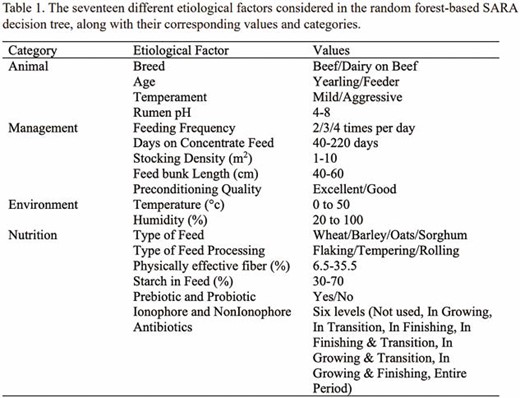-
PDF
- Split View
-
Views
-
Cite
Cite
Karun Kaniyamattam, Vishnudas Veettil, Madeline E Rivera, Luiz Diaz Batista, Luis O Tedeschi, 159 Design and Development Mechanics of a Random Forest-Based Decision-Tree Model for Sub-Acute Rumen Acidosis Management in Feedlots, Journal of Animal Science, Volume 101, Issue Supplement_3, November 2023, Pages 55–56, https://doi.org/10.1093/jas/skad281.069
Close - Share Icon Share
Abstract
Sub-acute rumen acidosis (SARA) is a ruminal digestive disorder with a prevalence of 24 to 30% in United States-based feedlots and is responsible for a lost economic opportunity of approximately $1 billion annually. Our objective for this study was to develop a decision tool which feedlot decision-makers could use to make routine managemental interventions that can mitigate the prevalence of SARA. The continuous reduction in rumen pH (pH < 5.6) is the primary causative factor that triggers its onset. However, this prolonged lower rumen pH results from the interaction between multiple other etiological factors. We developed a random forest-based decision tree prediction tool which used seventeen plausible etiological factors, which we broadly classified under four categories, namely 1) animal factors, 2) nutritional factors, 3) environmental factors, and 4) management factors (Table 1), to predict the probability of SARA in a typical US feedlot. A synthetic dataset of 100 observations was created based on a survey conducted among subject matter experts, including ruminant nutritionists, epidemiologists, and decision modelers to chart out the alleged relationship between the above seventeen etiological factors and the probability of a beef cattle population contracting SARA. The random forest model (R, 2021) was used to train as well as test the boot-strapped (80:20 split) synthetic dataset. Ability of random forest to limit overfitting without substantially increasing error due to bias contributed to the high positive predictive value (84%) of the model. Our results indicated that beef yearling cattle with mild temperament, with a rumen pH maintained above 5.6, while being fed three or more times a day, for more than 150 days on concentrate feed, with a stocking density greater than 7 m2, with excellent preconditioning, fed either sorghum or oats which are tempered with a physically effective fiber of 15% and above, under ambient temperature and humidity, along with the feeding of prebiotics, probiotics and ionophores had the least probability to contract SARA. In conclusion, our model can be used by feedlot decision modelers to test different permutations and combinations of these seventeen etiological factors customized to their respective operations to predict the probability of SARA in their herd. Future studies will improve the accuracy of the model by training it on more robust epidemiological datasets sourced from beef herds located in multiple geographic regions.




